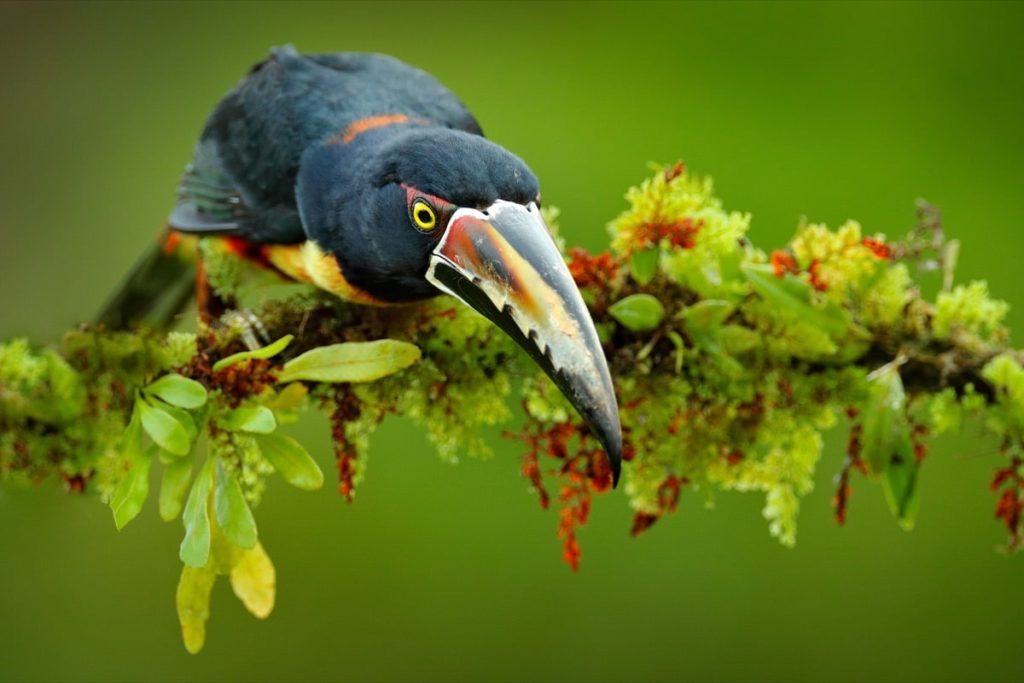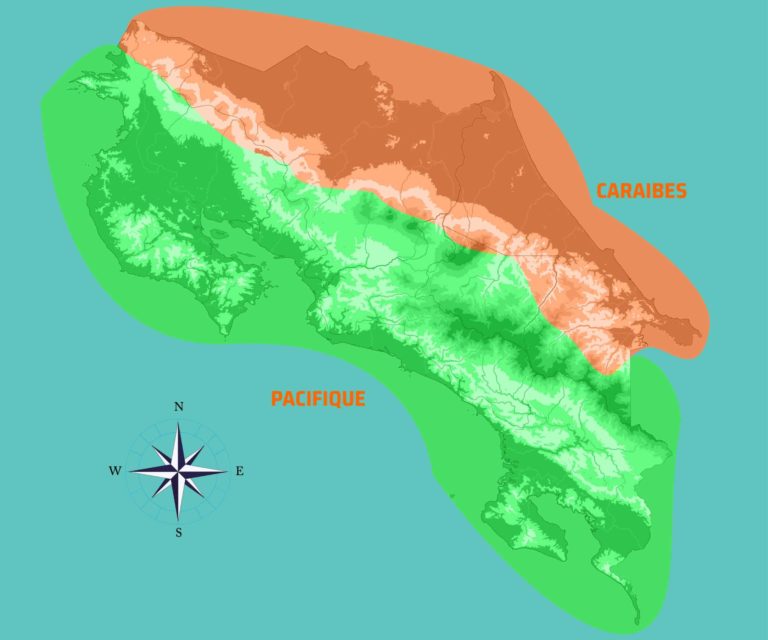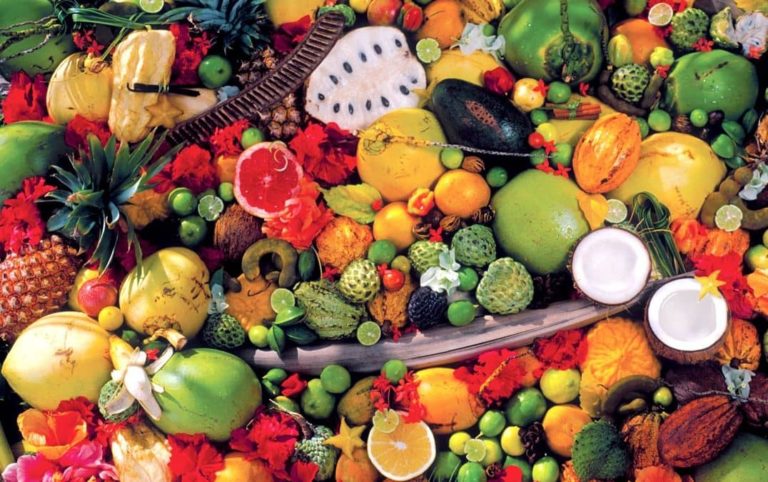Regions more than seasons
It would be a lie to describe the climate in Costa Rica month by month. When it’s sunny in the west, it can be deluging in the east, and vice versa. However, there are some major trends, and from December to April, the entire Pacific coast enjoys a hot and dry climate, while the Caribbean region experiences heavy rains. From May to October, the Caribbean enjoys more sunshine, while the South Pacific is well-watered, mainly in September and October.
However, the good news is that most of Costa Rica’s tours and attractions can be enjoyed year-round, depending on your interests and preferences. If you’re here to observe the abundant and active wildlife, May to August is the best time to visit. If you prefer very warm days and basking in the sun, December to April will enchant you.
Here is a table showing the main differences in rainfall and sunny days by region. Never lose sight of one important point: humidity = coolness = active and present animals. Basically, rain is part of the country and its wealth. A nice tropical downpour at the end of the day has the advantage of allowing you to sleep cool.
Precipitation and temperatures by region
| Month | ||
|---|---|---|
| Jan | 26,2 | 68 |
| Feb | 26,5 | 32 |
| March | 27,7 | 54 |
| April | 28,2 | 157 |
| May | 27,6 | 392 |
| June | 26,7 | 429 |
| July | 27 | 453 |
| Aug | 26,6 | 487 |
| Sept | 26,2 | 523 |
| Oct | 26,2 | 627 |
| Nov | 25,7 | 374 |
| Déc | 25,7 | 147 |
| Month | ||
|---|---|---|
| Jan | 26 | 62 |
| Feb | 26,3 | 61 |
| March | 27,4 | 94 |
| April | 27,9 | 215 |
| May | 27,3 | 399 |
| June | 26,5 | 388 |
| July | 26,6 | 371 |
| Aug | 26,3 | 426 |
| Sept | 26 | 468 |
| Oct | 25,7 | 664 |
| Nov | 25,4 | 347 |
| Déc | 25,5 | 107 |
| Month | Temp. | En mm |
|---|---|---|
| Jan | 24,6 | 49 |
| Feb | 24,9 | 38 |
| March | 25,9 | 87 |
| April | 26,1 | 220 |
| May | 25,5 | 433 |
| June | 24,9 | 378 |
| July | 25 | 303 |
| Aug | 24,7 | 410 |
| Sept | 24,4 | 494 |
| Oct | 24,3 | 571 |
| Nov | 24 | 280 |
| Dec | 24,1 | 76 |
| Month | Temp. | En mm |
|---|---|---|
| Jan | 25,6 | 286 |
| Feb | 25,9 | 187 |
| March | 26,9 | 182 |
| April | 27,4 | 274 |
| May | 27,1 | 272 |
| June | 26,4 | 257 |
| July | 26,6 | 378 |
| Aug | 26,4 | 288 |
| Sept | 26,2 | 128 |
| Oct | 25,9 | 172 |
| Nov | 25,4 | 345 |
| Dec | 25,3 | 425 |
| ARENAL – TENORIO | ||
|---|---|---|
| Month | Temp. | En mm |
| Jan | 22,8 | 281 |
| Feb | 23,1 | 182 |
| March | 24 | 108 |
| April | 24,4 | 124 |
| May | 24,2 | 330 |
| June | 23,6 | 464 |
| July | 23,5 | 576 |
| Aug | 23,4 | 509 |
| Sept | 23,2 | 505 |
| Oct | 23 | 525 |
| Nov | 22,9 | 459 |
| Dec | 22,5 | 469 |
| Month | ||
|---|---|---|
| Jan | 25,3 | 2 |
| Feb | 25,7 | 7 |
| March | 26,9 | 2 |
| April | 27,4 | 44 |
| May | 26,8 | 209 |
| June | 25,8 | 229 |
| July | 26,1 | 180 |
| Aug | 25,8 | 247 |
| Sept | 25,4 | 338 |
| Oct | 25,2 | 301 |
| Nov | 24,9 | 115 |
| Dec | 24,7 | 21 |
| Month | ||
|---|---|---|
| Jan | 22,8 | 35 |
| Feb | 23,2 | 19 |
| March | 24,1 | 44 |
| April | 24,5 | 143 |
| May | 23,9 | 345 |
| June | 23,3 | 346 |
| July | 23,5 | 316 |
| Aug | 23,2 | 399 |
| Sept | 23 | 422 |
| Oct | 23 | 512 |
| Nov | 22,6 | 277 |
| Dec | 22,4 | 86 |
| CENTRAL VALLEY | ||
|---|---|---|
| Month | Temp. | En mm |
| Jan | 20,2 | 18 |
| Feb | 20,6 | 15 |
| March | 21,3 | 23 |
| April | 21,9 | 78 |
| May | 21,6 | 343 |
| June | 21,2 | 382 |
| July | 21,1 | 282 |
| Aug | 21,1 | 383 |
| Sept | 20,8 | 464 |
| Oct | 20,5 | 472 |
| Nov | 20,3 | 214 |
| Dec | 20 | 56 |
Best seasons for species observation
Below are the best times to observe marine species in Costa Rica.
Some of these species are present year-round, such as dolphins on the Pacific coast from the north to the south, and to a lesser extent on the Caribbean coast.
In Tortuguero, manatees, an endangered species, are still present, but you’ll have little chance of spotting them due to their shy nature.
WHALE SHARKS | HUMPBACK WHALES | GREEN AND BLACK TURTLES | LOGGERHEAD AND HAWKSBILL TURTLES | TORTUES LUTH | TORTUES OLIVATRE | TORTUES CAOUANNE |
||||||||
|---|---|---|---|---|---|---|---|---|---|---|---|---|---|---|
January | Golfo Dulce | South Pac. | Pac. Nord Sporadic | South Pac. | North Pac. | Pac. Nord | Pac. Sud | |||||||
February | Golfo Dulce | South Pac. | Pac. Nord Sporadic | South Pac. | North Pac. | Pac. Nord | ||||||||
March | Golfo Dulce | South Pac. | South Pac. | |||||||||||
April | Golfo Dulce | South Pac. | ||||||||||||
May | Caraïbes |
|||||||||||||
June | Caraïbes | Caraïbes | Pac. Sud | Caraïbes |
||||||||||
July | South Pac. | Carribean | South Pac. | Carribean | Caraïbes | Pac. Nord | Pac. Sud | Caraïbes |
||||||
August | South Pac. | Carribean | South Pac. | Carribean | Caraïbes | Pac. Sud | Pac. Nord | Pac. Sud | Caraïbes |
|||||
September | South Pac. | Carribean | South Pac. | Carribean | Caraïbes | Pac. Sud | Pac. Nord | Pac. Sud | ||||||
October | South Pac. | North Pac. | South Pac. | Caribbean | Caraïbes | Pac. Nord | Pac. Sud | Pac. Nord | Pac. Sud | |||||
November | North Pac. Sporadic | South Pac. | North Pac. | Pac. Nord | Pac. Sud | Pac. Nord | ||||||||
December | North Pac. Sporadic | South Pac. | North Pac. | Pac. Nord | Pac. Sud | |||||||||
If you’re on this page, it’s probably because 850 bird species are catching your eye. Costa Rica has become a benchmark in ornithology. The country welcomes migrants from the north in January and February, and vice versa, those from the south in September and October.

The Toucans
All year round you can observe toucans in Tortuguero, Sarapiqui, Arenal, Tenorio, Monteverde, the Caribbean coast, the Pacific coast and especially in the south, the Osa Peninsula.

Macaws
You’ll have the opportunity to observe Scarlet Macaws throughout the year, particularly in the Central Pacific and the Osa Peninsula. The Nicoya Peninsula also benefits from several successful reintroduction projects.
Below are Costa Rica’s iconic birds. The best times for observation are the nesting periods indicated in color in the table.
Ambigus Green Macaw
| Quetzal
| Araponga tricaronculatus
| Unicolor Penelope Résident | Ruby-throated hummingbird Migrateur | Calliste safran Résident | American Jabiru Résident |
|||||||||
|---|---|---|---|---|---|---|---|---|---|---|---|---|---|---|---|
January | North zone | Dota | Palo verde tempisque | Caño Negro |
|||||||||||
February | North zone | Dota | Central Cordillera | Palo verde tempisque | Caño Negro |
||||||||||
March | North zone | Dota | Monteverde | Monteverde | Tapantí | La amistad | Central Cordillera | Guanacaste / Guiones – Pelada | Ujarras / Cartago | Palo verde tempisque | Caño Negro |
||||
April | North zone | Dota | Monteverde | Monteverde | Tapantí | La amistad | Central Cordillera | Guanacaste / Guiones – Pelada | Ujarras / Cartago | Turrialba | |||||
May | North zone | Dota | Monteverde | Monteverde | Tapantí | La amistad | Central Cordillera | Guanacaste / Guiones – Pelada | Ujarras / Cartago | Turrialba | |||||
June | North zone | Dota | Monteverde | Monteverde | Tapantí | La amistad | Central Cordillera | Central Valley | Turrialba | Tortuguero | |||||
July | Monteverde | Monteverde | Tapantí | La amistad | Central Valley | Arenal | Turrialba | Tortuguero | |||||||
August | Monteverde | Monteverde | Tapantí | La amistad | Central Valley | Arenal | Turrialba | Tortuguero | |||||||
September | Central Valley | Arenal | Tortuguero | ||||||||||||
October | Central Valley | Arenal | Tortuguero | ||||||||||||
November | Dota | Arenal | Palo verde tempisque | Caño Negro |
|||||||||||
Décember | Dota | Palo verde tempisque | Caño Negro |
||||||||||||
A recent look at Costa Rica
Why travel with us?

A flawless reputation since 2008

A single contact in English

Our presence on the ground all year round

Our expertise for a tailor-made offer





